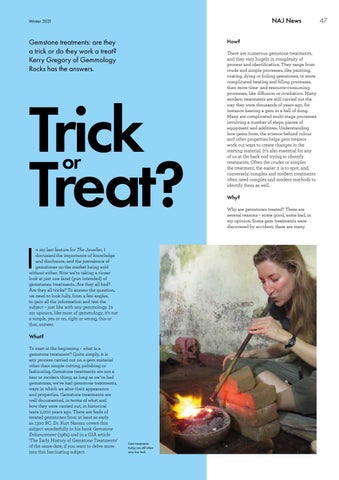NAJ News
Winter 2021
Gemstone treatments: are they a trick or do they work a treat? Kerry Gregory of Gemmology Rocks has the answers.
How?
Trick Treat? or
I
n my last feature for The Jeweller, I discussed the importance of knowledge and disclosure, and the prevalence of gemstones on the market being sold without either. Now we’re taking a closer look at just one facet (pun intended) of gemstones: treatments. Are they all bad? Are they all tricks? To answer the question, we need to look fully, from a few angles, to gain all the information and test the subject – just like with any gemmology. In my opinion, like most of gemmology, it’s not a simple, yes or no, right or wrong, this or that, answer.
What? To start at the beginning – what is a gemstone treatment? Quite simply, it is any process carried out on a gem material other than simple cutting, polishing or fashioning. Gemstone treatments are not a new or modern thing; as long as we’ve had gemstones, we’ve had gemstone treatments, ways in which we alter their appearance and properties. Gemstone treatments are well documented, in terms of what and how they were carried out, in historical texts 2,000 years ago. There are finds of treated gemstones from at least as early as 1300 BC. Dr. Kurt Nassau covers this subject wonderfully in his book Gemstone Enhancement (1984) and in a GIA article ‘The Early History of Gemstone Treatments’ of the same date, if you want to delve more into this fascinating subject.
Gem treatments today are still often very low tech
There are numerous gemstone treatments, and they vary hugely in complexity of process and identification. They range from crude and simple processes, like painting, coating, dying or foiling gemstones, to more complicated heating and filling processes, then more time- and resource-consuming processes, like diffusion or irradiation. Many modern treatments are still carried out the way they were thousands of years ago, for instance heating a gem in a ball of dung. Many are complicated multi-stage processes involving a number of steps, pieces of equipment and additives. Understanding how gems form, the science behind colour and other properties helps gem treaters work out ways to create changes in the starting material. It’s also essential for any of us at the back end trying to identify treatments. Often the cruder or simpler the treatment, the easier it is to spot, and, conversely, complex and modern treatments often need complex and modern methods to identify them as well.
Why? Why are gemstones treated? There are several reasons – some good, some bad, in my opinion. Some gem treatments were discovered by accident; there are many
47
